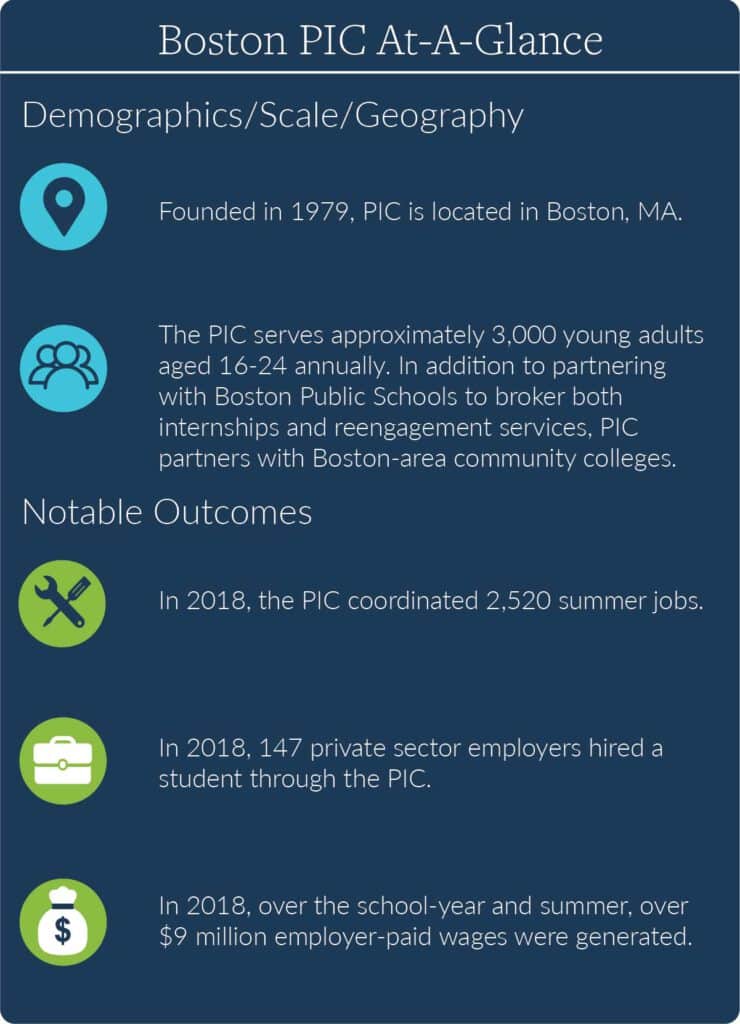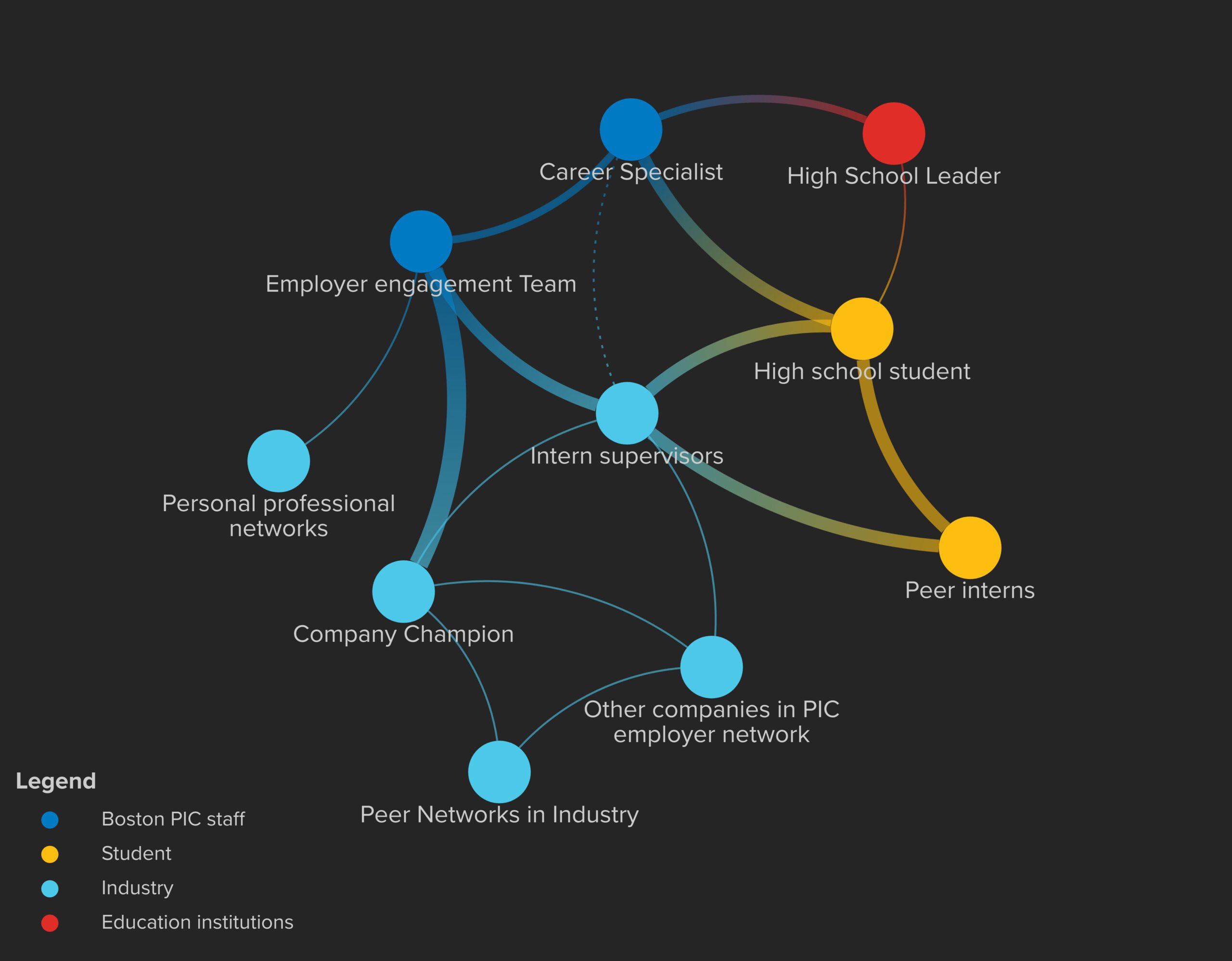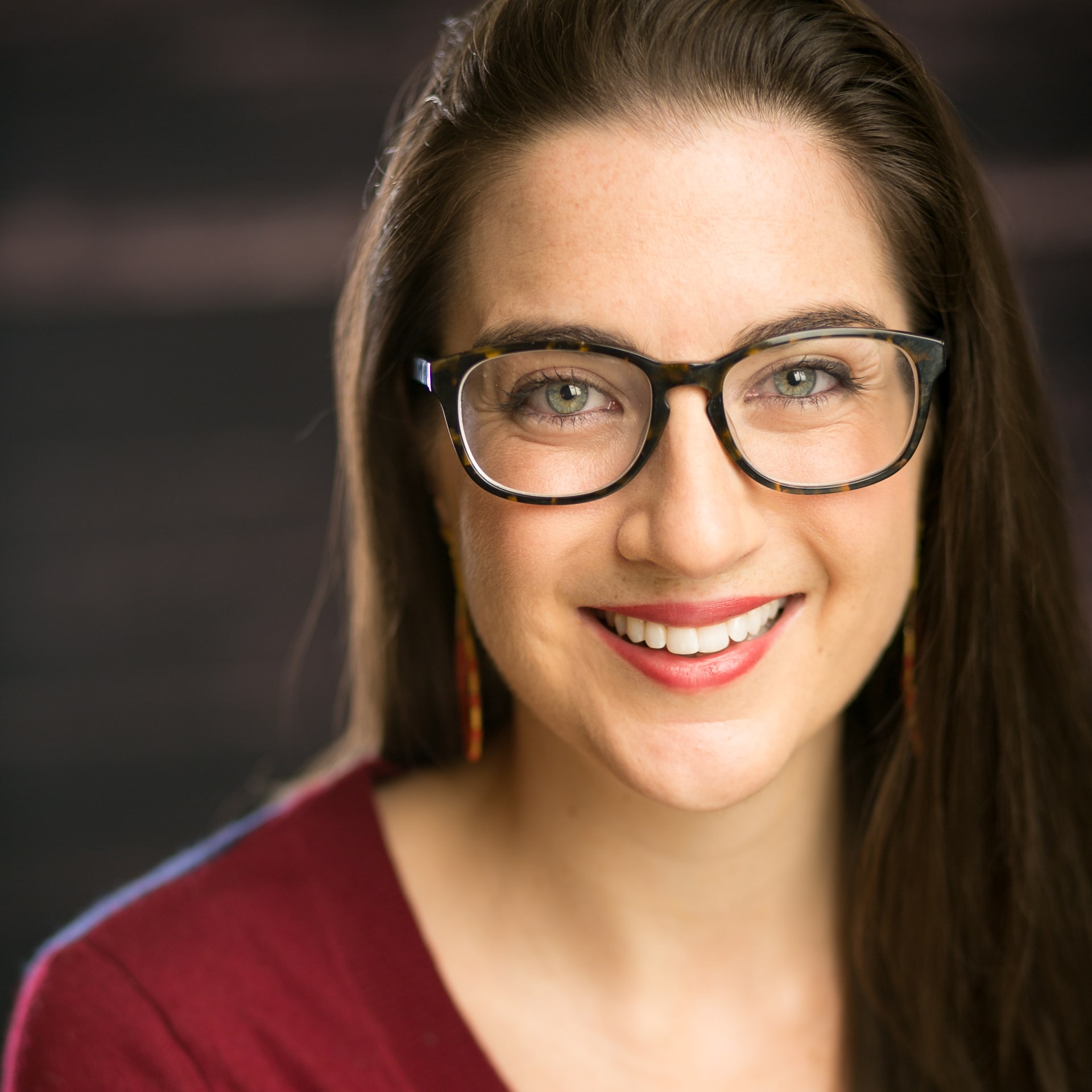Students need relationships to get by and to get ahead. But all too often in our education system, relationships are treated as inputs to learning, rather than outcomes in their own right. We’re offering in-depth profiles of programs that are flipping that script and deliberately designing models to deepen and diversify students’ networks. This is the third piece in our Who You Know in Action blog series. Read the first piece here and the second piece here.
This blog is co-authored with Charlotte Peyser.
“Disconnectedness is the new segregation.” This single statement sums up how Neil Sullivan, Executive Director of the Boston Private Industry Council (PIC), sees the critical role that connections play in leveling the playing field for young people in Boston and beyond.

The Boston PIC operates a host of programs—including a summer internship placement program for high schoolers, a community college coaching program, and a youth re-engagement center in partnership with Boston Public Schools. But for Sullivan, “We are more of a broker than a program. We work directly with students, and we develop and sustain relationships among programs, schools, and employers on their behalf.” Building an infrastructure that combats youth disconnectedness dictates the PIC’s programming efforts, not the other way around.
That helps to explain why the PIC operates an elaborate relationship infrastructure that spans its programming and partnerships. We took a close look at the particular network that PIC has built to support summer employment at scale across the city for all high school students, especially those often shut out of employment onramps and opportunities.
The map below shows this infrastructure first from the perspective of high school students that PIC serves (yellow dots). Beyond high schoolers themselves, the map reveals the extensive tentacles of behind-the-scenes networks that its staff (dark blue dots) maintains with schools (red dots) and a range of industry partners (light blue dots).

Investing in brokers
Brokers work at the intersections of systems. But while brokering can sound transactional, the PIC’s approach is deeply personal and aimed at unlocking new human connections. “We have front line staff doing community organizing to create experiences and networks that wouldn’t exist otherwise,” Sullivan said. These different brokers play various roles and interact as a coherent infrastructure to support scale:
- Career specialists in schools The largest share of PIC’s staff are career specialists who recruit and support students in securing summer jobs. Beginning in 10th grade, students in the Boston Public School System interact with 20 PIC career specialists who work in 32 of the district’s high schools. On the front end of the recruiting process, career specialists offer students structured support and frequent check-ins, especially for students who are less familiar to the PIC program. Throughout the school year, they assess students’ career interests, host workshops, and create career exploration opportunities. Career specialists also guide students through the PIC online internship application process to increase the likelihood that they secure a summer job that matches their skills and interests.As much as they are there to support students, career specialists are ultimately responsible for scaling warm handoffs, not deep connections. Because of the scale of the program and typical caseload (a single career specialist can support over 200 students at once), these career specialists are not high-touch mentors or job coaches. “We want intern supervisors [at companies] to be de facto mentors, not career specialists,” Sullivan said.
- Employer engagement team and networks If career specialists are the pipes connecting students to new work opportunities, then the PIC’s employer network is arguably the fuel of its summer internship model. PIC’s employer engagement team works to build connections with corporate, nonprofit, and government employers across the city. The relationships that the employer engagement team brokers are two-fold, but mutually reinforcing: relationships between students and businesses, and relationships between businesses and other businesses. Together with the PIC’s career specialists, the five-person employer engagement team serves, in Sullivan’s words, to “internalize the distance between schools and employers.” This team primarily forges connections with employers in four key, growing industries across Boston: health, technology, financial services, and life sciences. Half of the employer engagement team are themselves former career specialists while others are industry veterans. The team members all organize their own networks within industries, with a particular emphasis on cultivating “champions” in companies who can push for hiring PIC interns, as well as generating a set of referrals for employees who could serve as intern supervisors. The PIC’s employer engagement model clearly serves to stock the pond of internship opportunities for high school students across the city. But it also leverages network effects by generating opportunities for these employers themselves to come together. This brings more employers to the table not just to contribute to PIC’s mission, but also to network with one another. In turn, the PIC’s employer networks don’t only encourage participation—they also become distribution channels through which best practices for overseeing interns can grow. The network becomes a space where employers can exchange suggestions on how to give young people a great workplace experience. “It’s more powerful to hear advice from another employer rather than from PIC,” Sullivan said.
- Peer networks Although students themselves are not official brokers like the rest of the PIC staff, they are core to the relationship infrastructure behind PIC’s summer employment model. Throughout the school year and summer, students bond with one another as they travel to PIC or to a job site from their various high schools. Peers can be as crucial as career specialists and intern supervisors in making the program successful. As PIC’s School-to-Career Director Josh Bruno emphasizes, “Students hold each other accountable. They lift each other up.” This infrastructure is especially powerful because it can cross geographic and class lines across the city. Over time, through trainings, job shadows, and internship experiences, students naturally gravitate to one another based on their shared professional interests—regardless of the school or neighborhood they hail from. Bruno informally measures student success not only in job or internship acquisition, but also by the ways in which students help one another develop. “Victory is when you can’t tell an exam school student from a student from the roughest high school,” Bruno said, “because they’ve helped each other and taken risks with peers in a workplace environment.” PIC tries to leverage these positive peer dynamics among employers by encouraging companies to take on multiple students as interns. In Bruno’s estimation, “Cool things start to happen when companies bring on a group of 10.” At that scale, students often hail from a wide array of high schools, and cohorts start to gel. Often these cohorts will form friendships, and end up spending time together outside of work and school.
Creating and distributing value
Opportunity is a social phenomenon—not merely based on hard and soft skills, but on the networks to which opportunity seekers have access. It follows that creating and distributing opportunities in new ways requires new forms of social infrastructure. The PIC is a clear example of one such infrastructure to scale employment opportunities. Its team and students are traversing the silos of school and work and nurturing new connections across the city. In other words, while we often think of new opportunities yielding new connections, new connections can also yield new opportunities. That’s where a relationships infrastructure like the PIC exemplifies what it means to be a broker, rather than a standalone program. “We need to be open to the fact that there needs to be organized connectedness,” Sullivan said.



